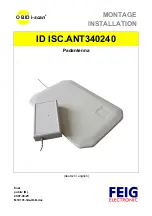
Leica Zeno GG04, Operation
15
3
Operation
3.1
Guidelines for Correct Results with GNSS Surveys
Undisturbed satel-
lite signal reception
Successful GNSS measurements require undisturbed satellite signal reception, espe-
cially at the instrument which serves as a base. For kinematic use, be sure to select
measurement positions with best satellite reception possible. Use the instrument in
location which is free of obstructions such as trees, buildings or mountains for best
measurement results.
Centred instrument
Centre the instrument precisely over the target positions.
3.2
Batteries
3.2.1
Operating Principles
First-time
Use/Charging
Batteries
• The battery must be charged before using it for the first time because it is delivered
with an energy content as low as possible.
• The permissible temperature range for charging is from
0
°C to +40
°C/+32
°F to +104
°F. For optimal charging, we recommend charging
the batteries at a low ambient temperature of +10
°C to +20
°C/+50
°F to +68
°F
if possible.
• It is normal for the battery to become warm during charging. Using the chargers
recommended by Leica Geosystems, it is not possible to charge the battery once
the temperature is too high.
• For new batteries or batteries that have been stored for a long time (> three
months), it is effectual to make only one charge/discharge cycle.
• For Li-Ion batteries, a single discharging and charging cycle is sufficient. We recom-
mend carrying out the process when the battery capacity indicated on the charger
or on a Leica Geosystems product deviates significantly from the actual battery
capacity available.
Operation /
Discharging
• The batteries can be operated from −20
°C to +55
°C/−4
°F to +131
°F.
• Low operating temperatures reduce the capacity that can be drawn; high operating
temperatures reduce the service life of the battery.
All manuals and user guides at all-guides.com
Содержание Zeno GG04
Страница 29: ...All manuals and user guides at all guides com ...
















































